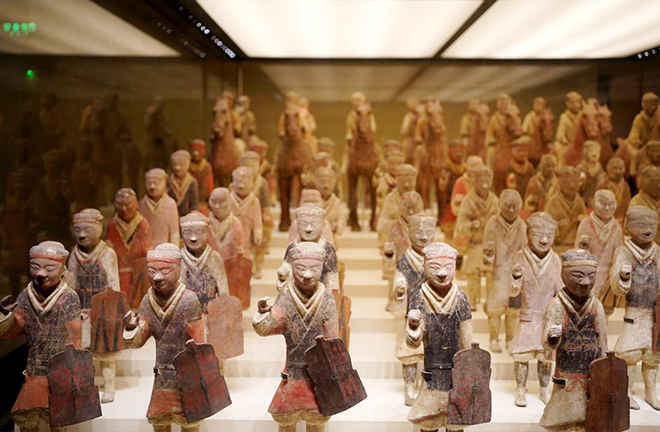Seminar presents Han Dynasty culture

Painted terra-cotta infantry and cavalry in the Western Han Dynasty displayed at the National Museum of China in Beijing Photo: Yang Lanlan/CSST
XUZHOU—In the axis of Chinese civilization, the cultures of the Western Han (206 BCE–8 CE) and Eastern Han (25–220) were largely inherited from the pre-Qin (prior to 221 BCE) culture, and inspired later dynasties, playing crucial roles in the formation of the Chinese cultural system. The Second Han Dynasty Culture Forum was held recently in Xuzhou, Jiangsu Province, at which scholars exchanged views on the theme of Han Dynasty culture and Chinese civilization.
Local identity
The splendid culture of the Han Dynasty constitutes an essential part of Chinese culture, creating numerous pioneering chapters in the fields of philosophy, religion, historiography, literature, art, education, etc. Featuring the “continuity, innovativeness, unity, inclusiveness, and peaceful nature” of Chinese civilization, it serves as the source and lifeblood of fine Chinese traditional culture.
During this era, Chinese culture achieved a state of “great unity” and matured, establishing a strong cultural foundation for the development of the Chinese nation. According to Liu Qingzhu, a Member of the Chinese Academy of Social Sciences (CASS), Han civilization is characterized by the ideological concept of “the same structure of the clan and country” and “co-construction of family and state,” forming a distinctive Chinese feature in world history. The idea of national “great unity” gave rise to a “national identity” and “ideological identity” among its citizens. The unity of the nation has supported the “continuity” of political development in Chinese civilization throughout history. Regardless of ruler, all acknowledged the states established in various periods and by different ethnic groups throughout the history of Chinese civilization.
“Han culture embodies a strong sense of attachment to homeland, and the identity of one’s home village or hometown and patriotism represents a precious legacy left by this culture,” said Bu Xianqun, director of the Institute of History at CASS and president of the Chinese Qin and Han History Research Association. Such concepts as “home village,” “hometown,” “old friend,” and “fellow villager,” represent prominent historical phenomena within the Han culture. The identity of home village is highly consistent with national identity, and the hometown awareness aligns with the mainstream national consciousness. Local identity is a crucial component of the Chinese people’s “profound historical consciousness,” serving as the intellectual foundation for maintaining national great unity.
The culture of the Han emerged as vivid brushstrokes in the canvas of Chinese civilization’s developmental history. Xuzhou, as the hometown of Liu Bang [the first emperor of the Han] and the foothold of Xiang Yu [defeated by Liu Bang over the control of China], holds great significance as the birthplace of Han culture. Song Lewei, secretary of the Xuzhou Municipal Party Committee, explained that Xuzhou preserves 544 Han cultural sites, along with 12,137 mobile cultural artifacts. It is home to the renowned “Three Wonders of the Han Dynasty,” namely, the Han tombs, the Han stone reliefs, and the Han Terracotta Warriors.
Innovative development
Han culture fully embodies the above-mentioned five prominent characteristics of Chinese civilization, consolidating the cultural identity deep within the souls of the Chinese people. According to Zhang Aijun, a member of the Standing Committee of the CPC Jiangsu Provincial Committee and head of the provincial publicity department, it is essential to continue this historical legacy, carry out the Jiangsu Regional Civilization Exploration Project, advance the outstanding traditional culture of Jiangsu with Han culture as its representative, and create the distinctive Jiangsu cultural brand featuring the charm of the historical Wu State (c. 1100–473 BCE) and Han Dynasty.
Pan Zhenzhou, former vice minister of culture and the first curator of the National Museum of China, highlighted the necessity of combining traditional Han Dynasty culture with contemporary aesthetic trends, fashion creativity, and consumer demand for the betterment of people’s lives.
Li Fengliang, party secretary of South China Agricultural University, emphasized the need to enrich the forms of cultural tourism and create multi-layered, multi-dimensional, high-quality cultural tourism experiences. He suggested promoting the use of resources based on the diversity of Han culture and facilitating the development of cultural projects. It is advisable to actively develop digital art and digital creative products, digitizing classic artworks of the Han and forging digital cultural tourism experiences.
The forum was co-hosted by the Publicity Department of the CPC Jiangsu Provincial Committee, the Chinese Qin and Han History Research Association, and the Xuzhou Municipal Party Committee and Municipal Government.
Edited by YANG LANLAN
